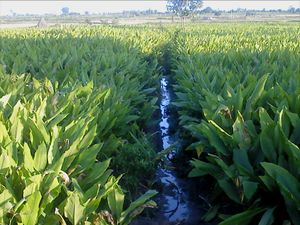Note: This is a project under development. The articles on this wiki are just being initiated and broadly incomplete. You can Help creating new pages.
Curcuma longa - Haridra
Turmeric (Curcuma longa) is a rhizomatous herbaceous perennial plant of the ginger family, Zingiberaceae. It is native to southern Asia, requiring temperatures between 20 and 30 °C (68 and 86 °F) and a considerable amount of annual rainfall to thrive. Plants are gathered annually for their rhizomes and propagated from some of those rhizomes in the following season.
When not used fresh, the rhizomes are boiled for about 30–45 minutes and then dried in hot ovens, after which they are ground into a deep-orange-yellow powder commonly used as a spice in Bangladeshi cuisine, Indian cuisine, Iranian cuisine, Pakistani cuisine and curries, for dyeing, and to impart color to mustard condiments.
In Ayurvedic practices, turmeric has been used to treat a variety of internal disorders, such as indigestion, throat infections, common colds, or liver ailments, as well as topically to cleanse wounds or treat skin sores.
Turmeric is considered auspicious and holy in India and has been used in various Hindu ceremonies for millennia. It remains popular in India for wedding and religious ceremonies.
Turmeric has played an important role in Hindu spiritualism. The robes of the Hindu monks were traditionally colored with a yellow dye made of turmeric. Because of its yellow-orange coloring, turmeric was associated with the sun or the Thirumal in the mythology of ancient Tamil religion. Yellow is the color of the solar plexus chakra which in traditional Tamil Siddha medicine is an energy center. Orange is the color of the sacral chakra.
The plant is used in Poosai (Tamil) to represent a form of the Tamil Goddess Kottravai. In Eastern India, the plant is used as one of the nine components of navapatrika along with young plantain or banana plant, taro leaves, barley (jayanti), wood apple (bilva), pomegranate (darimba), asoka, manaka or manakochu, and rice paddy. The Navaptrika worship is an important part of Durga festival rituals.
